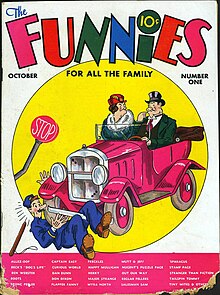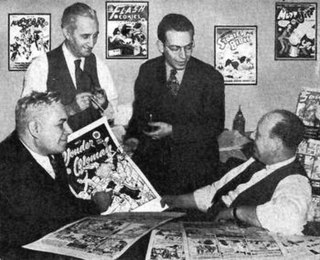
Maxwell Charles Gaines was an American publisher and a pioneering figure in the creation of the modern comic book.

Quality Comics was an American comic book publishing company which operated from 1937 to 1956 and was a creative, influential force in what historians and fans call the Golden Age of Comic Books.

An American comic book is a thin periodical originating in the United States, on average 32 pages, containing comics. While the form originated in 1933, American comic books first gained popularity after the 1938 publication of Action Comics, which included the debut of the superhero Superman. This was followed by a superhero boom that lasted until the end of World War II. After the war, while superheroes were marginalized, the comic book industry rapidly expanded and genres such as horror, crime, science fiction and romance became popular. The 1950s saw a gradual decline, due to a shift away from print media in the wake of television and the impact of the Comics Code Authority. The late 1950s and the 1960s saw a superhero revival and superheroes remained the dominant character archetype throughout the late 20th century into the 21st century.
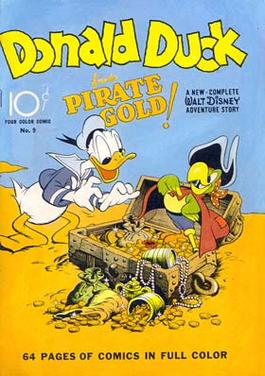
Four Color, also known as Four Color Comics and Dell Four Color, is an American comic book anthology series published by Dell Comics between 1939 and 1962. The title is a reference to the four basic colors used when printing comic books. The first 25 issues (1939–1942) are known as "series 1". In mid-1942, the numbering started over again, and "series 2" began. After the first hundred issues of the second series, Dell stopped putting the "Four Color Comics" designation on the books, but they continued the numbering system for twenty years.
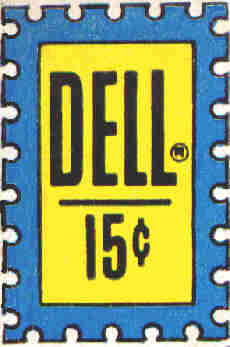
Dell Comics was the comic book publishing arm of Dell Publishing, which got its start in pulp magazines. It published comics from 1929 to 1973. At its peak, it was the most prominent and successful American company in the medium. In 1953 Dell claimed to be the world's largest comics publisher, selling 26 million copies each month.

Jane Arden was an internationally syndicated daily newspaper comic strip which ran from November 26, 1928 to January 20, 1968. The title character was the original "spunky girl reporter", actively seeking to infiltrate and expose criminal activity rather than just report on its consequences and served as a prototype for later characters such as Superman supporting character Lois Lane and fellow comic strip heroine Brenda Starr, Reporter. Pulitzer Prize-winning columnist Mary McGrory credited Jane Arden with instilling her interest in journalism.

More Fun Comics, originally titled New Fun: The Big Comic Magazine, is a 1935–1947 American comic book anthology that introduced several major superhero characters and was the first American comic book series to feature solely original material rather than reprints of newspaper comic strips. It was also the first publication of National Allied Publications, the company that would become DC Comics.

Mickey Finn was an American comic strip created by cartoonist Lank Leonard, which was syndicated to newspapers from April 6, 1936 to September 10, 1977. The successful lighthearted strip struck a balance between comedy and drama. It was adapted to a 400-page Little Big Book and was reprinted in several comic book series throughout the 1930s and 1940s.

Motion Picture Funnies Weekly is a 36-page American comic book created in 1939, and designed to be a promotional giveaway in movie theaters. While the idea proved unsuccessful, and only a handful of sample copies of issue #1 were printed, the periodical is historically important for introducing the enduring Marvel Comics character Namor the Sub-Mariner, created by writer-artist Bill Everett.
The Eastern Color Printing Company was a company that published comic books, beginning in 1933. At first, it was only newspaper comic strip reprints, but later on, original material was published. Eastern Color Printing was incorporated in 1928, and soon became successful by printing color newspaper sections for several New England and New York papers. Eastern is most notable for its production of Funnies on Parade and Famous Funnies, two publications that gave birth to the American comic book industry.

Dan Dunn is a fictional detective created by Norman W. Marsh. He first appeared in Detective Dan: Secret Operative No. 48, a proto-comic book from 1933, produced by Humor Publishing. He subsequently appeared in newspaper comic strips from 1933 to 1943.

Gordon G. Rogers, better known as Boody Rogers, was an American comic strip and comic book cartoonist who created the superhero parody Sparky Watts.

Funnies on Parade is an American giveaway publication of 1933 that was a precursor of comic books. The eight-page publication featured reprints of such popular syndicated comic strips as The Bungle Family, Joe Palooka, Keeping Up with the Joneses, Mutt and Jeff, Reg'lar Fellers, and Somebody's Stenog. Creators included F. O. Alexander, Gene Byrnes, Al Capp, Clare Victor Dwiggins, A. E. Hayward, C. M. Payne, Al Smith, and Harry J. Tuthill.
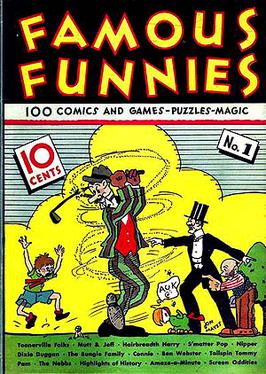
Famous Funnies is an American comic strip anthology series published from 1934 to 1955 with two precursor one-shots appearing in 1933–1934. Published by Eastern Color Printing, Famous Funnies is considered by popular culture historians as the first true American comic book, following seminal precursors.
Novelty Press was an American Golden Age comic-book publisher that operated from 1940 to 1949. It was the comic book imprint of Curtis Publishing Company, publisher of The Saturday Evening Post. Among Novelty's best-known and longest-running titles were the companion titles Blue Bolt and Target Comics.
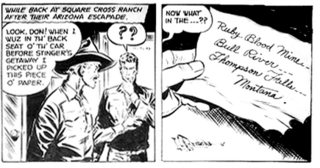
Don Winslow of the Navy was an American comic strip created by Frank Victor Martinek and distributed mostly by the Bell Syndicate from 1934 to 1955. The title character was a spy-chasing lieutenant commander in Naval intelligence. The comic strip led to a radio adventure serial that began in 1937, as well as film serials that began in 1942. Original comic book stories also appeared in Fawcett Comics titles starting in 1943.
The Sunday Funnies is a publication reprinting vintage Sunday comic strips at a large size (16"x22") in color. The format is similar to that traditionally used by newspapers to publish color comics, yet instead of newsprint, it is printed on a quality, non-glossy, 60-pound offset stock for clarity and longevity. Featured are classic American comic strips from the late 19th century to the 1930s. The publication's title is taken from the generic label often used for the color comics sections of Sunday newspapers.
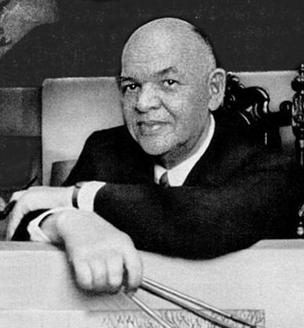
Elmer Cecil Stoner was an American comics artist and commercial illustrator. Stoner was one of the first African-American comic book artists, and is believed to have created the iconic Mr. Peanut mascot. He produced pencil art for the first issue of Detective Comics, published by National Comics Publications, and worked for a variety of other golden age companies such as Timely Comics, Street & Smith, EC Comics, Fawcett Comics, and Dell Comics. Near the end of his life, Stoner was also a spokesman for Gordon's Gin.

Norman Winfield Marsh was an American cartoonist and comic strip creator known for his character Dan Dunn, a hardboiled detective.
Associated Newspapers, Inc. was a print syndication service of columns and comic strips that was in operation from 1912 to c. 1966. The syndicate was originally a cooperative of four newspapers: The New York Globe, the Chicago Daily News, The Boston Globe, and the Philadelphia Bulletin. Associated Newspapers was led by Henry Herbert McClure (1874-1938), a cousin of S. S. McClure, founder of the McClure Syndicate, the first American newspaper syndicate. In 1930, Associated Newspapers was acquired by and became a subsidiary of the Bell Syndicate. The syndicate's most successful, long-running strip was Gladys Parker's Mopsy.

